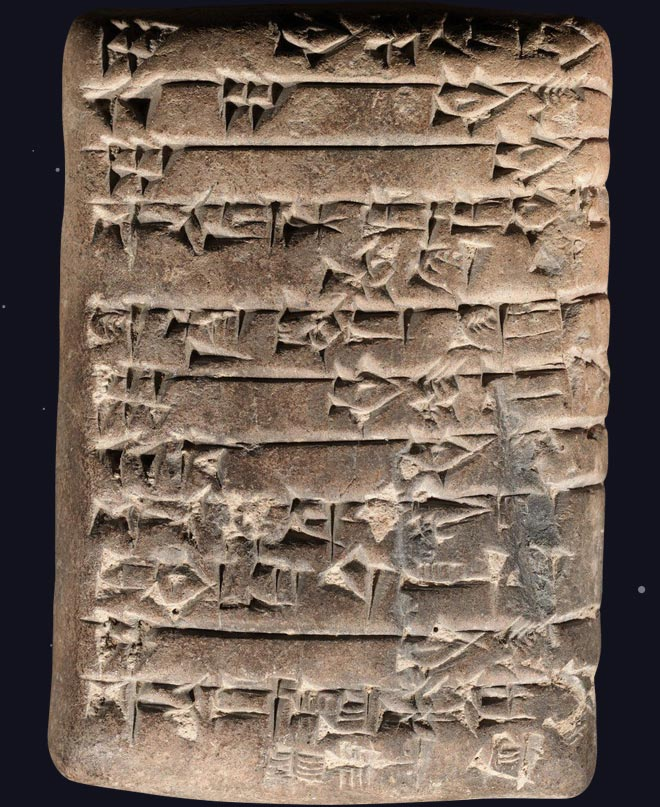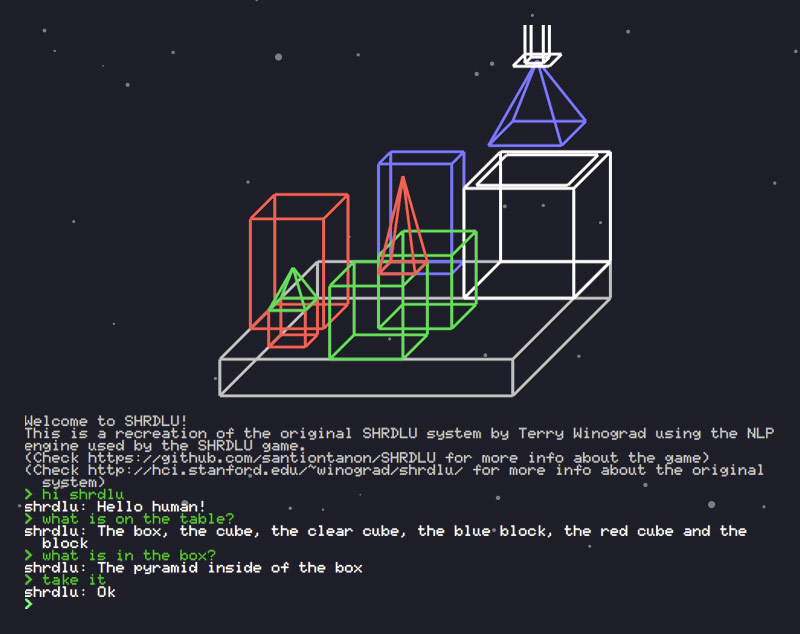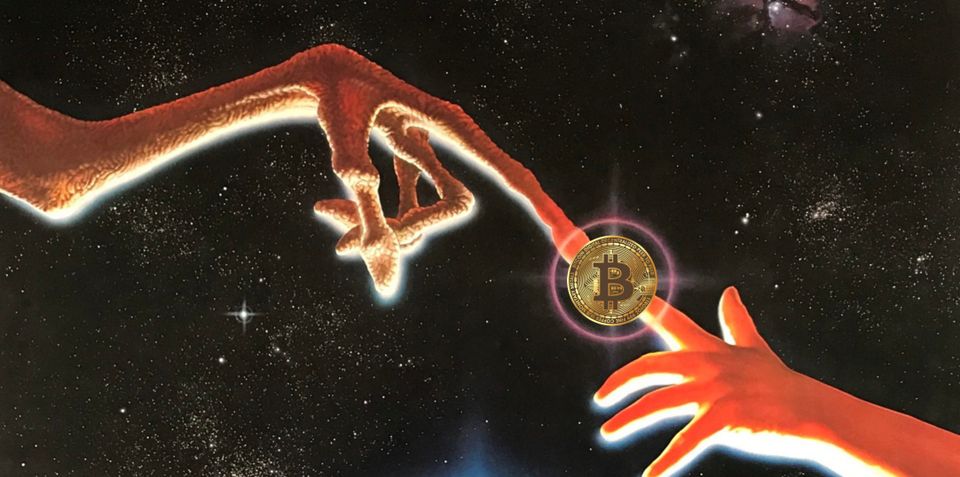This essay by Dhruv Bansal was published in Unchained blog.
This is Part III in a series of speculations about the hyperbitcoinized future. In Part I, we defined the First Law of Bitcoin Astronomy and described how it leads to new blockchains as humanity expands through the solar system. In Part II, we described a Second Law which leads to nested blockchains the size of solar systems and beyond, hashing vast energies on cosmic timescales.
Though we did discuss interstellar colonies and blockchains, we focused our attention in Parts I & II on our solar system and species. In this part, we expand our perspective to include the whole galaxy and the other species and civilizations that may already call it home.
We begin with a warning about the dangers of generalizing about other civilizations when we have only our own civilization as an example. Yet we will press on regardless and speculate that aliens, assuming they exist, are likely to develop blockchains of their own. Our galaxy may be full of technological, communicating, proof-of-work hashing alien civilizations.
What will happen when we detect their block headers?
The Mirror of Universality #
“Perhaps the most valuable part of [these] extraordinary [speculations] is going to be the mirror with which we confront ourselves obliquely…as we try to ask the question “What the future is like?"
— Philip Morrison, Prof. of Physics, MIT (source)
Our speculations about extraterrestrial life are always biased by our understanding of ourselves. NASA’s maxim for finding life in our solar system — Follow the water — assumes life elsewhere requires liquid water because all life on Earth does.
Similarly, our speculations about alien civilizations are biased by our own culture, technology and history. The Search for Extraterrestrial Intelligence (SETI) assumes aliens are talking to us because we ourselves like to be heard. SETI listens for narrow-band radio signals because that’s how we communicate here on Earth.
We cannot escape our biases, but we can temper them with the knowledge that alien life and civilizations, should they exist, must operate by the shared rules of our common universe. If our speculations are to avoid anthropomorphism, we must identify universals — properties which are likely to characterize life and civilization anywhere they occur.
Unfortunately, our sample size of one biosphere with one (young?) civilization makes it difficult to define such universals. Though all life on Earth shares the same liquid water-based biochemistry, this is no guarantee that life elsewhere must do so. And though radio waves are a natural technology for interstellar communication, it’s possible that ours is the only civilization to use them. The vast scale of the universe and the tremendous variation it contains potentially means there are no universals that characterize life and civilization.
We may be completely alone in the universe, a temporary statistical fluke in entropy production needing neither explaining nor purpose. Or perhaps the universe is full of life that is incomprehensible to our physics and biology; beings we cannot grasp experiencing realities we cannot conceive.

“When you look into the mirror it is not ET you see, but reflections of yourself posed universally.” — John Updike on SETI. [Source]
Speculating about universal properties of life and civilization is thus a kind of mirror we hold up to ourselves and our own civilization. The reflection we see may teach us more about ourselves than it does about aliens.
Life is Common #
But that doesn’t mean we have no objective basis from which to begin our speculations.
The fossil record confirms that simple life began on Earth almost immediately after our planet cooled. Either life can evolve from matter quickly or life was already around, waiting to settle in. Life on Earth also survived several mass extinctions due to geological processes, biofeedback, and asteroid impacts. This means life is hardy; where the conditions are right, it persists.
Astrobiologists increasingly believe that conditions are frequently right for life. Hydrogen, oxygen, carbon and the life-sustaining molecules they form are the most common substances in the universe and we know there are millions, potentially billions, of rocky planets just like Earth orbiting stars just like our Sun in our galaxy alone.
Carbon-based, water-soluble simple life is probably common in our galaxy. If we allow ourselves to entertain the possibility of other, more exotic kinds of life, then life should only be more common.

Simple life such as found in this hydrothermal system in Dallol, Ethiopia, is probably common across the galaxy. [Source]
Since life is an active process, it alters its environment, creating chemical signatures whose spectra can be resolved from light years away. Earth’s oxygen-rich atmosphere, sustained by photosynthesis, has been visible across the galaxy for billions of years. We are about to launch telescopes capable of measuring the spectra of planets with biospheres like Earth’s orbiting faraway stars. If simple life is common in the galaxy, we will see evidence of it within the decade.
The Fermi Paradox #
“A sad spectacle. If they be inhabited, what a scope for misery and folly. If they be not inhabited, what a waste of space.”
— Thomas Carlyle on stars
But what about complex life, the kind we believe can evolve intelligence and civilizations?
Civilizations, like life itself, are active agents, transforming their environments and declaring their presence to the cosmos through methods both intended (signals & probes) and unintended (waste heat). The traditional wisdom of astrobiology, confirmed by decades of fruitless SETI searches, is that such civilizations cannot be common, as common as we suspect life to be, simply because we would have noticed them by now. This tension between how common life seems to be and the lack of any (credible) evidence of alien intelligence is sometimes referred to as the Fermi Paradox.

The “Fermi Paradox” supposedly originated in an offhand remark made by physicist Enrico Fermi during a lunchtime conversation about aliens. The galaxy is huge and old and intelligence has had many opportunities to evolve — so “Where is everybody?” [Source]
The Fermi Paradox isn’t really a paradox at all. A simple, if disappointing, “solution” to the “paradox” is that ours is the only intelligence in the galaxy.
Another, more optimistic solution is that we simply haven’t looked very hard. The galaxy is vast and we have expended few resources searching it for signals. It is possible for our galaxy to be home to thousands of alien civilizations at various levels of technological advancement yet for us to be completely oblivious to them all.
These are but two of the most straightforward solutions. There are many others, ranging from bleak (it is the nature of civilization to destroy itself), to terrifying (elder, predator civilizations exterminate all younger ones) to whimsical (our solar system is an interstellar zoo).
An entire class of proposed solutions relies upon the idea of a Great Filter: something that prevents matter from evolving into communicating, technological civilizations. Great Filters are evolutionary, sociological, or technological barriers that many or most forms of life and civilizations never surmount, explaining why the galaxy is so quiet. Examples include the evolution of multicellular life, or intelligence or the ability to survive exponential population growth and environmental degradation after industrial revolutions.
Cosmic Sociology #
Solutions to the Fermi Paradox often make general statements about the motivations and behaviors of all possible extraterrestrial civilizations, yet we lack any examples of civilizations other than our own — so how can we possibly generalize?
We can’t. Building a sociological theory of extraterrestrial civilizations through an inductive, data-driven scientific process is impossible. If we are to construct believable solutions to the Fermi Paradox, we must use a more deductive method.
In his novel, The Dark Forest, the science-fiction author Cixin Liu gives a name to this mode of deduction: “Cosmic Sociology” (no doubt a department in the same building as Bitcoin Astronomy). As one character explains, when there is “nothing concrete to study” and “surveys and experiments aren’t possible,” then the “ultimate result will be purely theoretical.” She goes on to describe “axioms” – what we would call universals — which she believes characterize extraterrestrial civilizations.

Cixin Liu’s The Dark Forest may reveal more about its author or US-China politics than it does about the Fermi Paradox. [Source]
We won’t further spoil the plot, but suffice to say that her deductions about the interstellar society of civilizations lead to a terrifying resolution to the Fermi Paradox. It’s not science, but it is compelling science fiction because Liu’s choice of universals creates a reflection of our own civilization, recognizable yet dark.
Proposed solutions to the Fermi Paradox are often a kind of cosmic sociology: conclusions about the behavior of extraterrestrial civilizations based on elevating certain aspects of our own civilization to universals. They are not solutions to a paradox or problem but rather interpretations of humanity’s future; reflections in the mirror of universality.
Blockchains are Universal #
What do we see when we look in the mirror? It’s clear that we want to see blockchains. But it’s no fun to simply declare that blockchains make reasonable universals for technological civilizations — we must motivate this conclusion somehow.
Bitcoin arose on Earth from other, proximate technologies to solve coordination problems. If these proximate technologies and coordination problems themselves are universal, then blockchains should be common through convergent evolution.
Looking in the mirror again, let us practice cosmic sociology and begin with some more conservative universals. Communicating, technological civilizations.
- Have a society. Civilizations are composed of separate individuals acting out of rational self-interest with imperfect information.
- Have finite resources. Civilizations are constrained by finite supplies of matter and energy.
- Have no magic. No civilization possesses technologies we consider impossible today (e.g. instantaneous communication or travel).
(1) means we’re not considering hive minds or perfectly-coordinated machine-intelligences — not because they cannot exist, but because we cannot understand their evolution or motivations.
Similarly (2) means we discount civilizations such as Star Trek’s Federation, where replicators can create anything one wishes and where money is obsolete because the only scarcity is the Captain’s chair.
On the contrary, no matter how advanced a civilization’s technology or culture, by (3) they must play by the same rules as we do. They must have limited resources and unlimited ambitions. Like us, they must still develop mechanisms for the allocation of scarce resources across competing individuals and conflicting interests.
Let’s see how a conservative choice of universals (1) – (3) leads to the convergent evolution of bitcoin-like blockchains among communicating, technological civilizations.
Social species use language & money #
Should we ever detect an extraterrestrial signal, we would hope for it to be a message created by language users like us. Oherwise all it tells us is “We are here and we have a transmitter.”
On Earth, the development of language was deeply intertwined with the evolution of social species such as humans. One of the reasons for our assumption (1), that alien civilizations are social species, is that we believe this makes them more likely to develop language and desire communications with other social species.
But social species are also more likely to develop money. In Shelling Out, Nick Szabo traces the evolutionary connections between money, cooperation, and competition in early human societies. Inventing money “enabled early modern humans to solve problems of cooperation that other animals cannot.” If the concept of money increases the fitness of social species then, like language, it may be a common adaptation evolved by successful social species.
Once it evolves, money may even drive the evolution of language. Some of the earliest known examples of written human language are Sumerian clay tokens and tablets which record ancient transactions and debts.

Clay tablets are ledgers which enable communication between civilizations across thousands of years of time. A blockchain is a ledger which enables communication between civilizations across thousands of years of space. [Source]
Early money in alien civilizations will be subject to the same selection pressures as early money on Earth. The soundness of a money is determined by the economy, not the biology of its users. If alien life chiefly arises on the surfaces of rocky planets, then metals such as gold might be comparably scarce, leading to their use as early monies on planets around the galaxy.
But will all civilizations that invent money subsequently also invent blockchains through convergent technological evolution?
Prerequisite technologies are universal #
This can only happen if the prerequisite technologies for blockchains such as telecommunications, computing, and cryptography are also universal.
There are good reasons to believe that telecommunications and computing are universal developments in any technological civilization. Social species that expand to cover their home planet or solar system will not do so without building telecommunications networks. Computing is required for automating large societies and solving difficult problems of space science. Both technologies are intimately related, each benefiting from progress in the other. Besides, civilizations that don’t develop these technologies won’t be able to send or receive signals, so we’ll consider them to be reasonable universals.
What about cryptography? Cryptography arose on Earth from the need to keep secrets. Individuals in social species are likely to keep secrets, whether to collaborate with others or just to preserve their own privacy. As social species develop technologies such as writing or communication networks, they will develop techniques to transmit secrets securely. If aliens keep secrets, they’ll invent cryptography.

P != NP means there exist questions with answers that are difficult to find but easy to check. This allows the cryptographic locks and keys that blockchains rely upon. [Source]
The particulars of alien cryptography might differ from ours. They might not use elliptic curves or modular arithmetic, but many computer scientists and mathematicians believe that P != NP, which implies that questions with answers that are difficult to find but easy to check will always exist. Technological advances (such as quantum computers) may make it easier to find answers to certain classes of questions, but there will never exist a machine or algorithm which can efficiently answer every question. This means cryptography is universal.
So if alien civilizations use money and develop telecommunications, computing, and cryptography, they’ll have the necessary prerequisites to invent blockchains. But how do we know that they won’t eventually invent something better?
The Third Law #
A fundamental assumption of this series is that proof-of-work blockchains such as bitcoin are the optimal form of money. There is nothing better.
Blockchains with “more powerful” virtual machines, which “get around” proof-of-work, or employ “quantum magic” don’t exist or are bad ideas. The finite speed of communications, the energy costs of proof-of-work, and the long timescales of block settlement are essential features of bitcoin and all successful blockchains.
Consider the two “laws” we proposed in Parts I & II of this series:
The First Law of Bitcoin Astronomy (or “The Law of Hash Horizons”): Given constant hashrate, as a miner moves away from the center of hash of a blockchain, the number of blocks won by that miner statistically trends towards zero.
The Second Law of Bitcoin Astronomy (or “The Hash Exclusion Principle”): Discrete physical and temporal scales provide hierarchical states for blockchains to occupy in order of increasing energy and distance from Earth.
The First Law implies that blockchains are limited by the speed of light to have a finite size related to their block time. But this limitation incentivizes remote distant human colonies to build their own blockchains and defends them against aggression from incumbent empires. This encourages human expansion.
Similarly, the Second Law forces successful blockchains to occupy a discrete spectrum of energy scales, sizes, and locations. This constraint ensures cooperation rather than competition between blockchains, political groups, or people of different energy scales, locations, and time preferences. Discrete blockchains bootstrap our civilization up the Kardashev scale, a necessary requirement for us to become an advanced, space-faring civilization capable of settling nearby stars.
Bitcoin’s constraints are not limitations that civilizations eventually evolve or innovate past. They are fundamental drivers of human — and alien — growth and innovation.
Alien species which evolve language, money, telecommunications, computing, and cryptography should also develop a bitcoin-like blockchain through convergent evolution. They will then experience their own version of hyperbitcoinization. This will also cause them to expand through their solar system and ascend the Kardashev scale. Blockchains are universal because hyperbitcoinization-induced expansion increases a species’ evolutionary fitness.
Viewed at an even grander scale, life is a process which increases its internal order by exploiting free energy gradients. Life is robust and common because it is thermodynamically favorable: the waste heat it produces has higher entropy than the energy it consumes.
Species which evolve blockchains increase internal order, energy usage and entropy production from planetary to interstellar scales. This makes blockchains thermodynamically favorable adaptations as well.
We summarize these conclusions in a Third Law of Bitcoin Astronomy, the last of this series:
The Third Law of Bitcoin Astronomy (or “The Law of Hash Universality”): Proof-of-work blockchains such as bitcoin are a universal adaptation among communicating, technological civilizations.
The rest of this article pursues the consequences of the Third Law for SETI, first contact, and the Fermi Paradox.
Blockchains are the signal #
Let us assume that technological civilizations are numerous and long-lived enough in the galaxy so that each should expect to interact with several others during its lifetime.
Just as we tend to assume alien civilizations know about radio waves and nuclear fusion, taking the Third Law seriously means we should assume that each of these civilizations also knows about and uses blockchains.
There’s a general belief among SETI researchers that, should humanity actually discover or interact with another alien civilization then it’s likely for that civilization to be far more technologically advanced than we are.
The combination of these ideas leads us to speculate that the first SETI signal humanity will detect will be an alien blockchain.

Humanity has already transmitted sound money into space. Aliens will do the same, except they won’t send a golden record. They’ll send a blockchain. [Source]
Nakamotans and Xenocoin #
Suppose there exists an advanced (Kardashev Type 2.x) alien civilization occupying our neighborhood of the galaxy. Though we will never find out what they call themselves in their own myriad languages, we will refer to them here as the Nakamotans.
We don’t know whether the Nakamotan civilization is composed of one government, culture, or even species, but we do know that their recorded history is many hundreds of thousands of years long.
As anticipated by the Third Law, they invented their version of bitcoin long, long ago on a planet a few tens of light-years distant from Earth, at a time when humanity was inventing language. Since then they have settled many star systems and built many stellar blockchains such as Solcoin.
They’ve even built an interstellar blockchain with block times of centuries to coordinate across their whole civilization and make investments on the longest of timescales. We’ll refer to this blockchain as Xenocoin. Xenocoin is central to the Nakamotans. It’s the largest, most valuable, and lowest time-preference blockchain in their civilization. In many ways, it is their civilization.

The Nakamotans are the most advanced civilization in our galactic neighborhood. They are at least Type II on the Kardashev scale and have settled multiple star systems, all connected through an interstellar blockchain called Xenocoin. [Source]
The Nakamotans have known about Earth for a long time. For most of their history, we were just another oxygen-rich, life-bearing world on the edge of their civilization. Too remote to settle, too uninteresting to explore, and likely to be already inhabited by some simian or cetaceous bio-archetype of dubious intelligence.
But recently, the closest Nakamotan settlements to Earth began to notice some evidence of artificial signals emanating from our solar system. Some Nakamotan interest decides they should send us a message. What should they say?
Science fiction often posits that advanced civilizations send “Hello” messages, sometimes including mathematical, pictorial or, in a third kind of story, musical structure. We have sent already transmitted such messages ourselves, through radio waves and artifacts attached to our space probes.
But we’re not considering arbitrary science fiction aliens. Our aliens are Nakamotans. What kind of message would Nakamotans send us? There can be only one answer: sound money, the blocks and transactions of Xenocoin.
Xenocoin transmissions are commonplace #
One reason Nakamotans are likely to send us Xenocoin is that Xenocoin blocks & transactions are already some of the most common and powerful transmissions in their interstellar communications networks.
The archetypal “Hello” first contact messages in science fiction originate from elder civilizations and are broadcast in every direction through space. They are cosmic lighthouses, greeting young civilizations as they enter the galactic community.
But omnidirectional broadcasting on the interstellar scale isn’t cheap, it requires hundreds of trillions of watts, many times more energy than used by our entire civilization today. Even advanced societies such as Nakamotans, who perhaps can afford such an energy expense, will probably instead choose more efficient methods of communication.

Interstellar communications networks are unicast, peer-to-peer, and lack delivery guarantees. What applications could you build on such a network? [Source]
A narrow, directed beam such as a laser can transmit information over extremely long distances for much lower energy cost than an omnidirectional beacon. The trade-off is that senders need to aim this beam at their intended recipients. This is unicast, not broadcast communications.
Communication also requires that receivers must be listening at the time signals arrive from senders. Since interstellar transmission times are so long, senders should periodically retransmit messages if they want to be sure they are received.
So, if it exists, interstellar communication at scale looks something like a unicast, peer-to-peer network with frequent repetition due to a lack of transmission guarantees. Not every application is compatible with this network architecture.
But blockchains such as Xenocoin are. The high availability and partition-ability of blockchains and their built-in long consensus times are ideal matches for interstellar communications networks.
Nakamotans have been transmitting Xenocoin blocks for millenia within their own civilization’s interstellar communication networks. Xenocoin transactions are the most important and widely relayed messages in Nakamotan networks.
Our solar system could be embedded within a Nakamotan neighborhood full of Xenocoin transmissions, yet we might never have seen any of these signals because none were aimed directly at us at the time we were listening. But because of how common they are, it’s possible that the first extraterrestrial signal humanity ever detects is a Xenocoin transmission that wasn’t even aimed at us.
Nakamotans are incentivized to transmit Xenocoin #
But say we don’t see a random or errant Nakamotan message. Suppose instead that some individuals or groups of Nakamotans decide to send a message to humanity on purpose. Why should this message be Xenocoin?
Blockchains are for the Nakamotans what language is for us humans. Their society, technology and perhaps their very minds have been shaped by blockchains for millenia. Nakamotans might regard a civilization that hasn’t discovered blockchains the way we might regard a civilization that hasn’t discovered language: barely a civilization at all.
Sending a newly discovered species Xenocoin and gauging their response may be the Nakamotan way to measure worthiness in conversation and trading partners. They may have even done this many times in the past for other species they discovered and integrated into their civilization.
But even if Nakamotan scientists are endlessly curious about human civilization (perhaps we are also the first intelligent alien civilization they’ve found), they’re still likely to send us Xenocoin messages.
This is because the more civilizations that learn of Xenocoin, the more copies of the Xenocoin blockchain that exist, the more secure and valuable Xenocoin becomes. Nakamotans want us to use Xenocoin. They are incentivized to transmit Xenocoin messages even at considerable expense, repeatedly, and without any guarantee of response: the exact qualities SETI looks for in a signal.
Communicating is computing #
Nakamotans don’t just send us Xenocoin because they’re greedy. Sending Xenocoin is a good idea because the optimal way to transmit a cross-species message may be to first transmit a computer. Let’s use the example of data compression to illustrate this idea.
A common way to reduce the transmission costs of messages is to compress all data being sent. The trade-off is that receivers must decompress the data. This requires receivers to have a computer program that understands how the compression was originally performed in order to undo it.
We (de)compress data all the time behind the scenes on our human Internet. But if an alien civilization wanted to send us a large amount of compressed data, how could they ensure we have the appropriate decompression program? ZIP is barely a standard on Earth, much less the galaxy.
They might rely upon us to reverse-engineer the compression algorithm, but an easier method would be to transmit the decompression program itself alongside the compressed data. But this just introduces another difficulty: how do we run this decompression program? We can’t possibly load it into our laptops?!
The ultimate solution is to transmit the computer itself. Extraterrestrial senders can include in their messages an (uncompressed) specification of the rules for a virtual machine. Virtual machines of quite simple designs can perform arbitrarily complex computations, given the right input.

Conway’s Game of Life is a virtual machine with extremely simple rules that can nonetheless perform arbitrary computations. [Source]
Receivers would use their own hardware and software to implement this virtual machine and then feed it the rest of the compressed message as input data. The result would — hopefully — be a decompressed message.
Computer experts should be feeling a mix of eagerness and horror at this point. From the programmer’s perspective, designing programs for aliens to run is awesome and people already love to do it. But from a security engineer’s perspective, this sounds like aliens asking us to install and run Java from an untrusted source.
There are good reasons for concern. The insolubility of the Halting problem means that the only sure way to know what a computer program does is to let it run until it consumes all its resources or decides to stop. What if the virtual machine we receive is a malicious AI? Some researchers believe that “complex messages would need to be destroyed in the risk averse case” because they “cannot be decontaminated with certainty, and…can pose an existential threat.”
Thankfully, not every virtual machine needs to be Turing-complete. We can solve the Halting problem for virtual machines with sufficient limitations. We can prove such machines consume a bounded amount of resources and only run fixed algorithms, such as decompression. This helps receivers trust virtual machines even though they cannot fathom their alien creators.
Blockchains are Schelling points #
But compression is just one simple example of the more general idea that limited virtual machines are a good way to communicate between species. Blockchain interpreters are limited virtual machines. This is another reason why Nakamotans will send us Xenocoin.
If a message contains an arbitrary virtual machine, say one for decompressing data (as in our example above), we are still left with the question of how to interpret its output. Even if we could find a way to structure this output as symbolic, audio, and/or visual information, how could we interpret that?
This is ultimately a problem of semiotics. To communicate in natural language, senders and receivers must share signs, combinations of signifiers (symbols, sounds, images, gestures) and things signified — ideas and concepts such as “We come in peace” or “Here is how to build a warp drive.” The difficulty of this problem shouldn’t be underestimated: the film Arrival spends much of its airtime on the characters learning how to interpret alien signs.
One way to reduce the difficulty of the semiotic problem is to restrict the universe of discourse. Instead of being able to signify any possible thing, if signs were assumed to be about a fixed number of classes of things signified then they would be easier to interpret.

Early computer language programs restricted their universe of discourse. What’s a naturally restricted universe of discourse for interspecies communication? [Source]
But the Nakamotans can’t tell us in advance how to limit our universe of discourse because we can’t communicate. That’s the problem we’re solving! Somehow, species must converge on the same universe of discourse without prior communication. There must exist a natural Schelling point for how to limit the shape and subject of an initial interstellar conversation.
We’ve discussed above that virtual machines are a natural way to communicate across space and so they form the structural half of this Schelling point: messages are programs. But species must also converge on the semantic half of the Schelling point: what does the program do?
The Third Law provides the answer. If all species use blockchains then blockchains are a Schelling point for the semantics of interstellar programs. The Nakamotans will send us the Xenocoin blockchain because they will assume that we will interpret any message we receive as a blockchain — because that’s what they would do. Reaching this Schelling point accomplishes three simultaneous objectives.
First, blockchain interpreters are limited by design: bitcoin’s Script is designed to halt on all inputs and consume a bounded amount of resources. Assuming first contact messages are blockchains decreases the risk senders ask receivers to take when implementing virtual machines to interpret their messages.
Second, reducing the universe of discourse to the paucity of concepts required to implement a blockchain greatly reduces the semiotic problem. While an interstellar blockchain such as Xenocoin is vastly greater in scale and hashrate than bitcoin, it operates on the same principles. If some signifier seems to play the role of a public key then senders can confidently assume that the thing signified is the public key itself.
Blockchain interpreters such as bitcoin’s Script do contain complex cryptographic algorithms (such as SHA256 hashing or ECDSA signing) as primitive opcodes. These algorithms aren’t likely to be universal across civilizations or blockchains, but if senders are already including a virtual machine for a blockchain interpreter, they can also include implementations of its cryptographic opcodes. This is similar to how the core bitcoin software distribution includes custom cryptographic routines alongside its virtual machine.
Finally, and most importantly, blockchain transactions are inherently opaque to all but their participants. They contain no semantic content. This relieves receivers from needing to interpret what they mean; we just need to ensure they validate.
If a message includes both blockchain interpreter and blockchain data then the two can be used to cross-validate each other, aiding in interpretation. The ultimate proof that receivers correctly understand the message is when they validate for themselves that the Xenocoin blockchain meets the consensus rules of Xenocoin.
The medium is the message #
But a blockchain isn’t just proof of successful transmission, it’s a self-validating history of a civilization’s economic activity. Just as ancient Sumerian clay tablets help us understand the Sumerian civilization, a blockchain helps us understand the civilization transmitting it. Nakamotans will send us Xenocoin because they want us to grok them.
A blockchain’s block time tells the receiver something about the physical scale of the sender’s civilization: block times of minutes for planetary blockchains, weeks for stellar, and centuries for interstellar blockchains such as Xenocoin. The long timescale of Xenocoin is an open invitation: it means Xenocoin’s hash horizon is correspondingly large, big enough to include us, should we choose to join it.
A blockchain’s length, in combination with its block time, tells the receiver about the age and economic history of the sender’s civilization. Are they a young Type I civilization with a stellar blockchain experiencing early monetization? Or an advanced, Type II civilization such as the Nakamotans with a mature interstellar blockchain such as Xenocoin? As we measure the velocity of distant stars through their Doppler shifts, we will measure the velocity of distant monies through their HODL waves.

Imagine the HODL waves chart for an interstellar blockchain with a 500,000 year history. [Source]
A blockchain’s weight, the proof-of-work done to construct it, tells the receiver about the economy of the sender’s civilization. Though the same virtual machine algorithm will require different amounts of real energy in different civilizations because of their different levels of computing technologies, a civilization can still estimate what it would cost them in compute and energy to mine the blocks they see in another civilization’s blockchain.
Any strong, repeating, narrow-band artificial signal the Nakamotans send us would be a technosignature — proof to us of an alien civilization. But a blockchain is a very special kind of self-validating, self-signifying technosignature. It cannot be faked, except at astronomical expense, and it comes with its own built-in interpretation. A blockchain is a thermodynamically signed, cryptographic proof of a civilization’s position on the Kardashev scale.
Sending us Xenocoin is a way for the Nakamotans to flex on us.
Blockchain as lingua franca #
First contact is as much a meeting of markets as it is tribes or species. Commerce is one of the chief drivers of exploration that causes distant tribes to meet in the first place. And the history of commerce is full of lingua francas, specialized jargons which develop to facilitate trade between tribes that speak different languages.
A conversation between humanity and the Nakamotans taking place over light years with the goal of coming to mutual understanding, knowledge, and prosperity could take millenia. Xenocoin serves as a lingua franca during this time. It maintains the conversation until both sides develop a better shared language, one capable of more a meaningful exchange of ideas than transactions and blocks.
If we’re lucky, the Nakamotans will be willing to invest in learning how to have more meaningful conversations with us. But the Nakamotans could be jaded or disinterested. Perhaps they are used to promising, young civilizations that nonetheless collapse, never to be heard from again. They’re willing to send us Xenocoin but they may not choose to make any further investments in learning our language till we prove ourselves worthy.
First Contact #
Let us assume that one day humanity detects a strong, repeating, narrow-band signal from an unknown Nakamotan entity. The signal is long and complex and is found to contain significant amounts of binary-encoded data. This message is subsequently found to contain the Xenocoin blockchain and virtual machine specification. How will our species react?
Blockchain Uplifting #
The Third Law asserts that all technological civilizations will develop bitcoin but it doesn’t preclude that some civilizations might learn about it from others.
So let’s first consider a counterfactual scenario: what if humanity were to receive this signal before Satoshi Nakamoto invented bitcoin? Could we have deciphered it?
Obviously, if it were hundreds of years ago, we would neither have detected it nor been able to understand it. But let’s assume the signal was received in 2005, years before bitcoin, but at a point in human history where encryption was already widely deployed on the Internet and cypherpunks had already experimented with projects such as HashCash, b-money, & bit gold.
Satoshi described bitcoin in English and familiar mathematics and implemented it using common programming languages, yet it is still difficult for most humans to understand how bitcoin works — many don’t even try. An alien blockchain might have been inscrutable.

In a timeline where humanity received a Xenocoin signal before we invented bitcoin, we might get the Xenocoin white paper instead of the bitcoin white paper.
But wouldn’t that only have made it more fascinating? Huge resources would have been spent by governments, universities, and corporations to “crack the signal”. Despite lacking an example blockchain of our own, assume that we are able to understand that we’re dealing with a virtual machine which does cryptography on a dataset. Someone (perhaps Satoshi!) would eventually have made the connection between proof-of-work, cryptographic money, and distributed ledgers.
The only hypothetical origin story for bitcoin more incredible than its real history would be that it was inspired by alien money from the stars. Whether this origin would have hastened or slowed bitcoin’s creation or adoption is anyone’s guess.
Resistance is Futile #
Thankfully, humanity already knows about bitcoin, so when we learn about Xenocoin we will be able to decipher it more quickly than if we had to figure out blockchains themselves first. We will quickly perceive the scale, age, and power of the Nakamotan civilization.
These numbers are likely to be so large that they frighten us. Entities with access to hashrate on such tremendous scales pose serious threats to human civilization. What if they coordinated to send a hash bomb, destroying bitcoin, Muskcoin, Solcoin or another human blockchain? What if they spent a similar amount of energy on real weapons?
Some elements of human society may despair or turn inward, believing the universe to be under a Pax Nakamota that provincial savages like ourselves should better avoid. Others may urge faster industrialization and greater investment in our own blockchains. Perhaps proof that a blockchain on the scale of Xenocoin can exist is what finally causes Solcoin to take off in our solar system: a mad idea suddenly proven right.
Others will realize that Xenocoin is an opportunity. Humanity may not yet have launched an interstellar blockchain of our own and, if we were to do so, it would have to compete against Xenocoin. Xenocoin’s far greater hashrate is likely to win. The endgame is clear: if we can’t compete with the Nakamotans then we must join them.
Running Xenocoin #
All we have to do to join the Xenocoin network is send Xenocoin back to the Nakamotan source we received it from. This tells the Nakamotans we are receiving their messages and that we have a transmitter.
It also shows them we’re not going to noise up the channel with useless “Hello” or “What is the secret of life?” messages. It lets them know we’re ready to participate more fully in their peer-to-peer network, in the Xenocoin blockchain.
Once they receive our response, the Nakamotan response might be to test us, sending us the occasional invalid Xenocoin transaction or block. If we blithely transmit these back, they’ll know we don’t yet understand the protocol. We might risk being put on a cosmic banlist for a few centuries.
But if, for many Xenocoin blocks, we consistently transmit back all valid transactions the Nakamotans send us, then they may begin to invest more resources in our relationship. Perhaps they would begin transmitting more frequently, continuously instead of periodically. We would respond in kind, committing more of our own energy budget towards maintaining this vital interstellar communications link.

We will build powerful orbital communications lasers to constantly maintain our link to the Nakamotan civilization. [Source]
At some point our Nakamotan peer would send us (or we might learn how to ask for ourselves) information about other Xenocoin peers. We would send signals to them as well, hopefully receiving back responses decades later. Each new peer we successfully connect to would lead us to discover its peers. We may realize that our galactic neighborhood is full of Xenocoin using star systems, all willing to peer with us since we now share the same economic language.
Our civilization would have become a full node in the Xenocoin blockchain.
Using Xenocoin #
It may take us centuries to become a well-connected Xenocoin node and to establish real communication with Nakamotan civilization. As we do, we are likely to have many questions we’d like the Nakamotans to answer.
Nakamotans may be open with us and answer our questions freely. They may be eager to communicate and willing to “uplift” our civilization. But they may also be reticent to interact with us, wary of exposing us to knowledge or technology we aren’t ready for — perhaps with historical reasons for why they feel this way.
But the Nakamotans aren’t a single entity, they’re a heterogenous civilization like us. They won’t act with complete uniformity and we needn’t rely upon their generosity. If we possessed Xenocoin, we could purchase what we wanted from willing Nakamotan individuals, companies, or distributed exchanges.
There are significant incentives for humanity to acquire Xenocoin. Factions of our civilization which do so first will wield significant power. They might be able to buy scientific breakthroughs or blueprints for advanced technologies. They might purchase training from Nakamotan educators for their engineers to build these technologies — or from Nakamotan defense contractors for their soldiers to wield them.

What incredible knowledge or technologies might the Nakamotans possess? [Source]
For obscene amounts of Xenocoin they might be able to pay real Nakamotan adventurers to travel to human settlements so that we may meet and study them — or worship them, for some. Or they might just get scammed by a Nakamotan Faketoshi.
Given the incentives to accumulate Xenocoin, the incentives to steal it will also be high. Custodying Xenocoin, the most valuable currency in the galaxy, will be too important to be left to any one individual or even any one world. Collaborative multisig custody on the cosmic scale, spread across planets and star systems, will be the only way to hold Xenocoin.
Mining Xenocoin #
But before we can spend or custody Xenocoin, we must possess some. How will humanity earn Xenocoin in the first place?
If Nakamotans are curious about us they might value information about our civilization and species. We might be savvy and view information about ourselves as the one asset we possess in greater abundance than an advanced civilization such as the Nakamotans. A small bubble of human history data speculation might tickle Nakamotan markets for a few thousand years.
But, eventually, the entire human Internet will be pirated and sold to the lowest Xenocoin bidder. And no matter how curious Nakamotans might have been about us, we’ll have little else to trade them that they don’t already know.
Nakamotans might be interested in acquiring human currencies. We might not have an interstellar blockchain that can compete with Xenocoin but Solcoin or other human blockchains may be collectibles for Nakamotan elite or institutions. Some Nakamotan investors might desire bitcoin just because of the memes.
If Xenocoin supports cross-chain atomic swaps then Nakamotan & human traders can trustlessly exchange Xenocoin and bitcoin, Solcoin, or the tokens of any other human blockchains. Eventually, as trade between our civilizations increases, exchange rates will emerge between human currencies and Xenocoin. These rates are interstellar valuations of the relative markets and prospects for Xenocoin and human blockchains.
The best way for humanity to earn Xenocoin, long-term, is for us to mine it. The crucible of human civilization is likely to be many light years away from the Xenocoin center of hash near the Nakamotan home worlds. But Xenocoin has a block time of centuries specifically so that civilizations like ours, many light years from the center of hash, can still mine. Nakamotans want us to mine Xenocoin because they want Xenocoin to grow. They might also be waiting for us to mine Xenocoin. The ability to do so indicates our civilization is worth investing further resources in.

Distributed Xenocoin mining pools allow us to combine our civilization’s hashrate with the much greater hashrate of Nakamotan star systems. [Source]
But given the huge hashrate of Xenocoin, mining any for ourselves will require joining a distributed Xenocoin mining pool. Nakamotans themselves likely use such pools to mine Xenocoin across the various star systems of their civilization. We could even join in pools with other Xenocoin using star systems. Perhaps there exists a Xenocoin mining pool favored by young civilizations such as ours, spread far and wide in between the pockets of much larger civilizations that make up the Nakamotan sphere.
Depending on the gap between humanity and the Nakamotans on the Kardashev scale, we may need to allocate a significant fraction of our hashrate over millenia if we’re ever to earn out meaningful amount of Xenocoin from our mining pool. Initially, few people will be willing to mine Xenocoin over Solcoin, bitcoin, or some other human blockchain. A hyperbitcoinized society’s energy and mining industries are deeply intertwined and both extremely efficient. In contrast, early human Xenocoin mining technology will be primitive and inefficient, preventing it from being rapidly adopted by the mining industry at scale.
But over time, humans will develop Xenocoin ASICs to make our miners more competitive in the broader Xenocoin hashrate market. And as we learn more about the Nakamotan civilization and what we can purchase with Xenocoin, our desire to possess it will increase. The combination will lead to gradual adoption of Xenocoin mining across human civilization. The long timescales of Xenocoin blocks means that few miners will dedicate 100% of their hashrate to Xenocoin — as discussed in Part II, the bitcoin and Solcoin markets will continue to exist and thrive. Miners will apportion some fraction of their hashrate to planetary, stellar, and interstellar blockchains as they see fit.
We may not have created Xenocoin but Xenocoin may nonetheless become our civilization’s interstellar blockchain. Even if we can’t communicate with the Nakamotans, we can still use Xenocoin within human civilization. As an interstellar blockchain with a huge hashrate, Xenocoin is already suitable for optimizing human interstellar trade networks and allowing humans to store value and manage risk across the longest timescales. It’s possible that the Nakamotan civilization is full of species that don’t communicate or trade greatly with each other but all use Xenocoin as their interstellar blockchain. It is in this sense what we meant earlier when we said that Xenocoin really is the Nakamotan civilization. By adopting and mining Xenocoin, we ourselves become Nakamotans. We become a Type II civilization.
Returning to the Fermi Paradox #
Let’s return to the Fermi Paradox, the tension between the size and age of the galaxy and the scant evidence of technological civilizations within it.
All our preceding speculations are compatible with a galaxy in which technological civilizations are extremely rare. If ours is the first technological civilization in the galaxy then we might be the future creators of Xenocoin. It’s possible that we are already the Nakamotans. In this case, the Third Law is inapplicable. Perhaps the development of blockchains is a Great Filter. Civilizations which don’t discover bitcoin never hyperbitcoinize and fail to develop the necessary energy economy to grow beyond their home planets.
But if technological civilizations are more common, then we must resolve the Fermi Paradox in a different way. We know that any “solution” is really an a reflection in the mirror of universality, an interpretation of humanity’s future based on what one believes about the present. With this understanding, and with many speculations about the Laws of Bitcoin Astronomy and alien blockchains behind us, we propose a new solution to the Fermi Paradox (a member of the “they’re waiting for our signal” family): we haven’t detected alien civilizations because we only just built bitcoin.

Aliens aren’t waiting for us to “phone home”, they’re waiting for our proof-of-work. [Source]
Advanced civilizations are out there but, because of the unicast structure of interstellar communications networks, they’re just not messaging us (or not doing so very frequently). This is because advanced blockchain-using civilizations don’t Follow the water like NASA, they Follow the hashrate. Just as we would be able to verify the scale of the Nakamotan civilization from their Xenocoin blockchain, our neighboring civilizations can verify the scale of human civilization from our own blockchain transmissions — or lack thereof. They may be waiting to message us until they can measure our position on the Kardashev scale through our proof-of-work.
Our species discovered radio communication 125 years ago. Theoretically, civilizations within 125 light years of our solar system may have detected signals from us. Practically, most of those signals are weak and unlikely to be detected. Strong signals from direct attempts at extraterrestrial communication such as the Arecibo message or the Voyager golden record might also have gone undetected as they were singular, not repeated transmissions. Even if some alien civilization had been listening at exactly the right time to detect them, the data they contain were probably uninterpretable. To a blockchain-using alien civilization, all our message would have signified is that we don’t understand the implications of the Third Law. We probably don’t have blockchains, we haven’t experienced hyperbitcoinization, and we haven’t reached Type I on the Kardashev scale. We’re simply not worth messaging.
The Fermi Paradox is a result of a relatively short gap — a few hundred years — in the history of human technology between developing telescopes, which make us more interested in nearby space, and developing bitcoin, which makes us more interesting to nearby civilizations which occupy that space. The longer our civilization takes to hyperbitcoinize, the slower we climb the Kardashev scale and the longer it takes us to join the market of worlds — a kind of Have Fun Staying Poor at the galactic scale.
But we do have bitcoin! And we are experiencing hyperbitcoinization. So, if we want to talk to ET, we should start by beaming the bitcoin blockchain to as many nearby star systems as possible, as frequently as possible. Can that Blockstream satellite be pointed…outward?
Thank you #
Many thanks to my colleagues at Unchained Capital for the many interesting conversations which lead to speculations such as these. Particular thanks are due to Destry Saul, Joe Kelly, Phil Geiger, Martin Grogono, Buck Perley, and Walden Raines, all of whom helped with discussion and review. I must also thank Velvet Campbell by assuring her that this is the last article I intend to write on this topic.